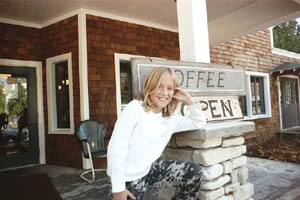
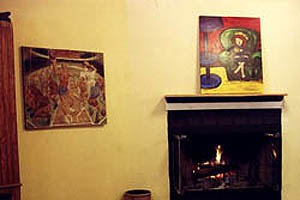
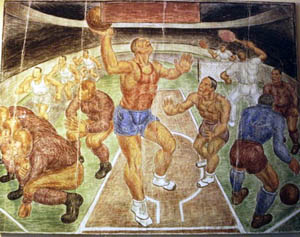
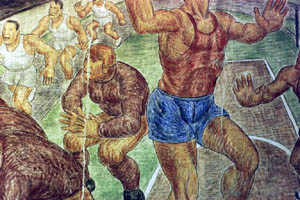
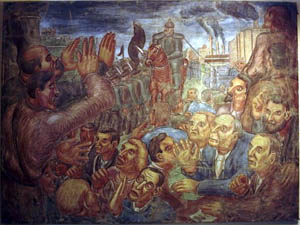
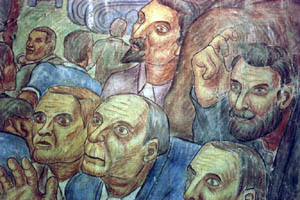
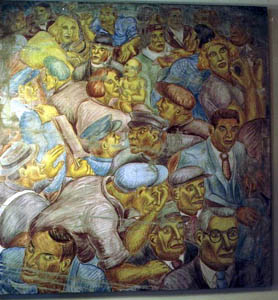
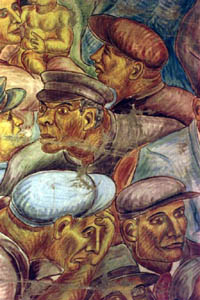
David Alfaro Siqueiros
Siqueiros - "Portrait of Mexico Today, 1932"
A Wall on the Fly The only Siqueiros mural left intact in L.A. completes a four-year trek to a Santa Barbara museum. Los Angeles Times October 6, 2002 By SUSAN EMERLING
When Mexican muralist and Communist agitator David Alfaro Siqueiros came to Los Angeles in 1932, he was a man on a mission. His goal in L.A., he wrote in his notebook, was to create "the great uncovered mural painting in the free air, facing the sun, facing the rain, for the masses."
It is no small irony that of the three murals Siqueiros painted during his eight-month stay here, only "Delivery of the Mexican Bourgeoisie Born of the Revolution in the Hands of Imperialism" (a.k.a. "Portrait of Mexico Today, 1932") survives intact--precisely because it was the only one never to have faced the sun, the rain or the masses.
Now the masses are about to get their chance. After 70 years sequestered on private property, "Mexico Today" will meet the people at the Santa Barbara Museum of Art, not as an open-air revolutionary salvo, but as a precious masterwork that has taken nearly four years and a million dollars to acquire, transport, restore and display.
"I think if Siqueiros were alive, he'd be amused at the irony of this work's survival and pleased that he has a public legacy," says Santa Barbara Museum of Art curator Diana du Pont, who oversaw the Siqueiros project.
However, Du Pont adds, "it is one thing to acquire a work like this, and another to move it. It was worth bringing the best talent in the world together to see if we could do it, rather than say it's too difficult, and just walk away."
The great mural move got its start in early 1998, shortly after the Santa Barbara Museum of Art's well-received exhibition "Portrait of a Decade: David Alfaro Siqueiros, 1930-1940." Du Pont, who had brought that exhibition to the museum, got a phone call inviting her to take a look at a Siqueiros mural in the courtyard of a private residence in the Pacific Palisades. The owners, she was told, might be interested in donating the mural, if the museum would take the responsibility for getting it off the property.
"It was like a dream," says Du Pont, who knew of the mural's existence but had never seen it. "You walk through the front gate, the main house is below, and to the right, connected to the front gate, is a garden portico where Siqueiros painted the mural."
Thirty-two feet long and 8 feet high, the brightly painted depiction of corrupt leaders and noble peasants wrapped around the interior walls of a semi-enclosed patio, topped by a weathered shake roof and complete with a brick floor dotted with splatterings from Siqueiros' brush.
"The folklore is, Siqueiros stood and framed the mural from the living room," Du Pont says. "It was part of the ambience of the home. You would see it coming out the front door."
With the blessing of the museum's director, Robert Frankel, Du Pont dispatched a team of conservators, contractors and scholars to the Pacific Palisades house. Could the mural be safely moved? How much would it cost? Where would they put it? Was it worth it? It took 2 1/2 years of brainstorming and discovery before they were ready to take action.
"The due diligence was phenomenal," she says.
To Du Pont's eye, the mural had made it to the end of the century in pristine condition. But under the microscopic scrutiny of the conservators, it suddenly seemed in imminent peril. The old roof was in danger of breaking loose and swinging into the face of the mural. Moisture from landscaping was seeping in from the outside wall. The front gate was sending vibrations through the approximately 260-square-foot structure. And if that weren't enough, in places, the painted surface was separating from the wall, and in some spots the paint was "dusting."
"The original paint was there," says Perry Huston, former chief conservator at the Amon Carter Museum and Santa Barbara's lead consultant on the mural project. "But the medium had gone, so it was just like chalk."
Moving so large a work of art presented even bigger problems. First, the team considered a common technique: stripping the paint layer off the wall and attaching it to another backing. "It would be the same paint that Siqueiros used," said Scott Haskins, an Italian-trained fresco specialist and principal of the Fine Arts Conservation Laboratory in Santa Barbara, "but it would destroy the mural."
The next choice was a method that went back to the 16th century, when writer-artist Giorgio Vasari used it to move a fresco out of the church of Santa Croce in Florence. Vasari cut through the wall surrounding the fresco, explains another team member, Andrea Rothe, senior conservator for special projects at the Getty, "put a wooden frame around it and pulled the whole thing out."
For the Palisades mural, the Vasari method meant cutting the patio enclosure into two or three pieces. "At the other end you put it back together," Huston explains.
But the Santa Barbara Museum decided it wanted something more. "They were interested in preserving a piece of history with the very best integrity possible," says Haskins--which is to say, keeping the entire structure intact: roof, bricks, walls and mural, and displaying it as much as possible as it existed in situ.
The team thought it could be done. "I'd cut foundations off and done all sorts of weird retrofits," says John Sullivan, a Santa Barbara contractor who was brought in to assess the heavy lifting, with engineer Gregory Van Sande. "I viewed the move as if it were a little earthquake."
The final plan called for stabilizing the mural's fragile painted surface, slipping a new steel foundation under the old walls, sawing the structure free, encasing it, lifting it onto a truck, driving it north and setting it down in front of the museum. All without cracking the walls or losing a flake of paint.
Du Pont and Frankel took the plan to the Santa Barbara museum trustees. According to Mercedes Eichholz, the board president, they raised $1 million to cover the budget for the project.
"The board had the vision to say go for it," Du Pont says, and the mural's owners, Robert and Justine Bloomingdale, turned the mural over to the museum as an anonymous gift.
In terms of time, resources and expertise, it would be the most ambitious acquisition in the museum's history.
These days, Mexico claims David Alfaro Siqueiros as one of its preeminent 20th century artists. But in 1932, he came to L.A. as persona non grata in his home country.
Two years earlier, his participation in a May Day rally had landed him in house arrest in Taxco. While there, he exhibited paintings of suffering peasants that did nothing to improve his legal situation.
The U.S., however, already under the spell of Mexican muralists Diego Rivera and José Clemente Orozco--with Siqueiros, they would become known as the Big Three of Mexican art--was ready to welcome him with open arms. At first.
An invitation to teach at Chouinard Art School in Pasadena provided Siqueiros' ticket out of Mexico. With his students, he created "Street Meeting" on an exterior wall. When the composition was nearly complete, Siqueiros sent the students home. He stayed up all night to complete the central figure. At the mural's unveiling, Siqueiros surprised and offended his politically conservative patrons with what he described as a "red-shirted orator" rallying "a hungry people."
Though there is no clear consensus as to whether the mural was deliberately destroyed or whether it vanished under the elements, within a year it would be gone.
Next, Siqueiros was commissioned to paint a mural on Olvera Street, in downtown L.A. By then, he was experimenting with quick-drying cement, industrial paints and an airbrush. The commission had asked for a rendition of a cheerful tropical paradise. Instead, he painted a pyramid, a jungle and indigenous Mexican symbols surrounding a crucified Indian hanging beneath the talons of an American eagle. In the upper right corner, a Mexican revolutionary and a Red Guard stood ready for revenge.
Again, the negative reaction was noisy. The mural was whitewashed, and over time, it has wasted away in the elements. (See sidebar.)
Siqueiros' final L.A. mural had to please only one man: Dudley Murphy, the director of "Emperor Jones," collaborator with Man Ray and Ferdinand Légèr on "Ballet Méchanique," and owner of a Spanish-style home in Pacific Palisades.
"Siqueiros and I became great friends," Murphy would write in an unpublished memoir, "and to help him out, I put all my furniture from my house in the garden and held a three-day exhibition of Siqueiros' paintings in my house.... Siqueiros sold about 10 of his paintings. Charles Laughton bought two.... Josef Von Sternberg bought one. In gratitude, Siqueiros offered to do a mural for me on the wall of the enclosed patio."
Murphy also got a long-term house guest--Siqueiros, lying low because his visa had run out, moved in and began painting. On the patio's long back wall, he put two mournful women and a naked child on the steps of another pyramid. Nearby sits Plutarco Elías Calles, president of Mexico from 1924 to 1928. He had come to power as a Communist and the artist dresses him as a revolutionary, but his red mask is falling off, and money bags lie at his feet.
On the patio sidewalls, two murdered peasants are wrapped in red and blue serapes, and a soldier of the Red Army arrives to aid the cause. The front of the patio is mostly open, with two short walls at either end. Siqueiros painted one a warm amber, and on the other, across from Calles, he "hung" a gold-framed picture of American financier J.P. Morgan.
"Morgan played an ugly role in subverting the oil industry in Mexico," says Shifra Goldman, a Los Angeles-based art historian who has written extensively on Siqueiros. "Morgan is the person who gave the gold to Calles."
Unlike Siqueiros' other patrons, Murphy cherished his mural. When he sold the house in 1946 to Minna and Willard Coe (ironically, Coe was a nephew of Morgan), they threatened to paint it out. "I had told him what a tragedy it would be," Murphy recalled. "But it wasn't until [Carlos] Chávez, the famous Mexican conductor, raved about the mural ... that they decided not only to preserve it, but to install special lighting and use it as a background for their entertaining."
The Bloomingdales, who declined to be interviewed for this story, acquired the house and the mural in 1986.
"Each successive year the reputation of Siqueiros and the importance of the work was gaining," says Du Pont, speaking for the couple. "They had a feeling of what is this doing here? It was not created for a public forum, but it belongs there now."
In 1991, the Bloomingdales offered the mural at auction--Christie's valued it at between $1.5 million and $2 million--with the stipulation that the buyer would be responsible for its removal. There were no takers. Seven years later came the call to the Santa Barbara Museum.
"The task of moving it was so great," says Du Pont, "that only a museum or an institution could do that."
It was July 2001 when Huston, Sullivan and the others arrived in Pacific Palisades to begin the move. Huston started by photographing the mural inch by inch. He gently brushed the dirt off its surface and, where there was dusting, applied medium to stabilize the color.
Then the conservators systematically tapped the surface, listening for hollows where the paintmight have separated from the wall beneath. Using a veterinary syringe, Haskins injected an adhesive behind the most precarious sections.
Solvents, to remove more dirt, came next, a step made more complex because Siqueiros had experimented with different kinds of paints. Mostly, though, he "used a synthetic resin-based paint onto Portland cement, thinking that if he applied it wet it might sink in better," Haskins says. "What happened is closer to getting oil and water to mix. He's lucky he got it to stick at all."
Keeping it stuck during the move was the conservators' biggest challenge--and, like Siqueiros, they decided to experiment.
In 1995, German conservators had developed a paraffin-like substance called cyclododecane. "This is one of the most remarkable materials in modern time," says the Getty's Rothe. Used on fragile surfaces, cyclododecane protects paint. Because it melts at low heat, it can be applied without exposing the artwork to radical changes in temperature. And it possesses one spectacular characteristic: It evaporates when exposed to air, leaving no residue.
"For the Siqueiros mural we used the cyclododecane in a molten state, applying a thin layer with a brush," says Gary McGowan, a New Jersey conservator imported for his cyclododecane expertise. "Then we applied a layer of gauze and layered up the cyclododecane. The gauze binds the wax layers together like a rigid surface, like a cast." When the cyclododecane "sublimates," the gauze falls away.
Until McGowan got his hands on the material, it was mostly used in small doses. He became its first industrial-sized user, protecting carvings made by slaves in the foundation of a church on the Underground Railroad. The application on "Mexico Today" expanded that usage six-fold.
Next, the coated surface was covered with sheets of plastic and plywood lined with foam. Then it was Sullivan's turn. His crew pulled off the patio roof (a replica would be made later), and removed the floor brick by brick, mapping and marking all the pieces. They wrapped a fiberglass skin around the outside of the structure for added strength and temporarily filled in the front gap to keep the walls from wracking.
The most dangerous moment came next. The crew dug a 4-foot trench around the patio, cored holes through the original foundation and inserted a cross-hatching of I-beams to support the walls. Then they cut below the beams, while Rothe, anxious about vibration, held his hand on the protected surface of the mural. To his amazement, the saws generated less vibration than the front gate.
On Oct. 10, 2001, the protected structure was strapped into a harness and hooked to a crane. "I was double-checking and triple-checking everything," Sullivan says. "I kept thinking, 'I know we cut the whole thing off--but maybe we didn't.' It really choked me up; I was very embarrassed. The guys were laughing at me."
His fears were well placed. The package weighed about 51,000 pounds, Van Sande says. "Any torquing could have destroyed the mural. Old plaster is very brittle."
The crane lifted its load over the front of the Palisades property and onto a 40-foot-long flatbed truck. Chained and bolted in place, it was driven up Highway 101 and stored overnight in Santa Barbara under police guard.
Before sunrise a small, coffee-cup-wielding crowd of museum staffers, trustees, Justine Bloomingdale and the mayor of Santa Barbara congregated on State Street. At dawn a crane drove into place. A few minutes later, a man on a bicycle launched into "Here Comes the Bride," as the delivery truck arrived.
The crowd, hands on heads, mouths open, watched while the mural floated over the tops of trees, executed a delicate 180-degree pirouette and hovered a few inches above its new foundation near the museum's main entrance.
After it was secured, Frankel and Huston pried off a section of plywood and scraped off a thumbnail sized bit of gauze and goo. So far, so good.
The Santa Barbara Museum of Art had planned to unveil "Mexico Today" in June, but by March, it was clear it wouldn't be ready--a cool winter had delayed the sublimation of the cyclododecane and the outlines of the mural were just starting to ghost through the milky surface.
Already, the brick floor had been puzzled back together and a replica of the original roof topped the old patio enclosure. The exterior walls were stuccoed over the fiberglass sheath and painted.
Then, a warm April accelerated the sublimation and, in May, the conservation team reconvened. Again, they went over the mural with a fine-tooth comb. The verdict? Pure glee. Even Huston, characterized by one of his colleagues as "Mr. Please" for his polite persistence and preternatural precaution, was excited. The mural looked right, and according to Huston, even the dust lodged in the existing cracks had made the trip from the Palisades to Santa Barbara intact.
Rothe pronounced the move an unprecedented success. "Absolutely spectacular. I think it is a 99.9% success rate, which is impossible with any intervention."
Du Pont was more than ready to begin what she referred to as "the presentation phase" of the project, when conservation gives way to restoration.
"Less is more," she said in May. "I don't like to go back to works of art and, what is it Ted Turner does? Colorize them. It does have a patina of age, that is part of its history. We're not going to give it a high-gloss finish. It never had it, and we're not going to apply it."
Still, obvious damage was repaired, such as the underside of Calles' sombrero, which had lost its contour and original color due to oxidation. "We'll just paint in reversible materials so you can take it off in the future without threatening the [original] paint," Huston said.
Though no one seemed to regret it, there was one major, inevitable loss: the way Siqueiros' composition related to its original domestic setting. Rothe acknowledged the problem: "In some ways the museum destroys the purpose of the work of art, but it protects it and preserves it and makes it available. This is an appropriate setting, even though it is not exactly where it was painted."
But Du Pont sees much to be gained by the new setting. In her view, critics and art historians have tended to under-appreciate "Mexico Today," ranking it too far below "América Tropical " on Olvera Street.
"It is not what one would call the best Siqueiros around," says Los Angeles Times art critic Christopher Knight, who has yet to see the mural in person. Its value in his view is more historical than artistic: "This is a fairly conservative example of an artist's in-your-face politically based painting."
Experts dismiss it "because they have not had the opportunity to examine it," Du Pont counters. "The beauty is that this is the very thing that preserved it. Murals are supposed to be public art, this work, in its monumentality and simplicity is there. Our hope is this is the beginning of the research and meaning of the piece."
"Portrait of Mexico Today, 1932" will be unveiled from 1-4 p.m., Oct. 20, Santa Barbara Museum of Art, 1130 State St., Santa Barbara. (805) 963-4364, http://www.sbmuseart.org
|
|
|
|
|
|
|
|
|
|
|
|
(photographs copyright 2002 Dan Hyde)
Biography Page
E-mail Nancy
Home
Copyright 2002 Parva Productions Ltd. All Rights Reserved.